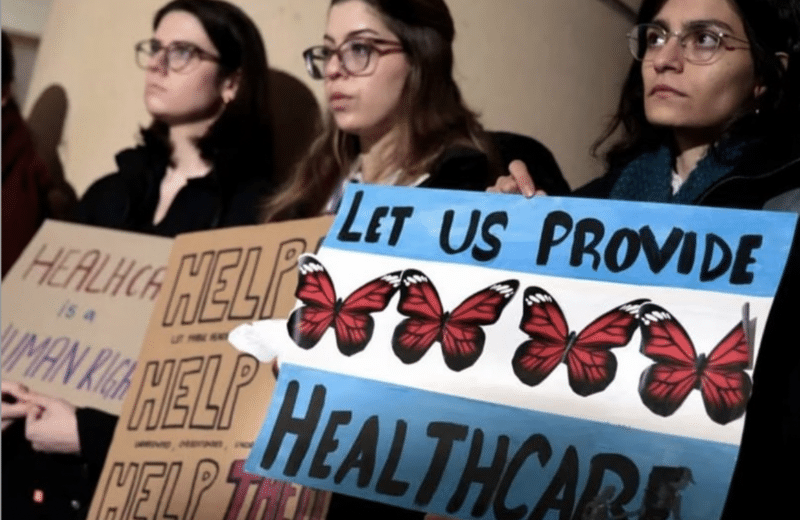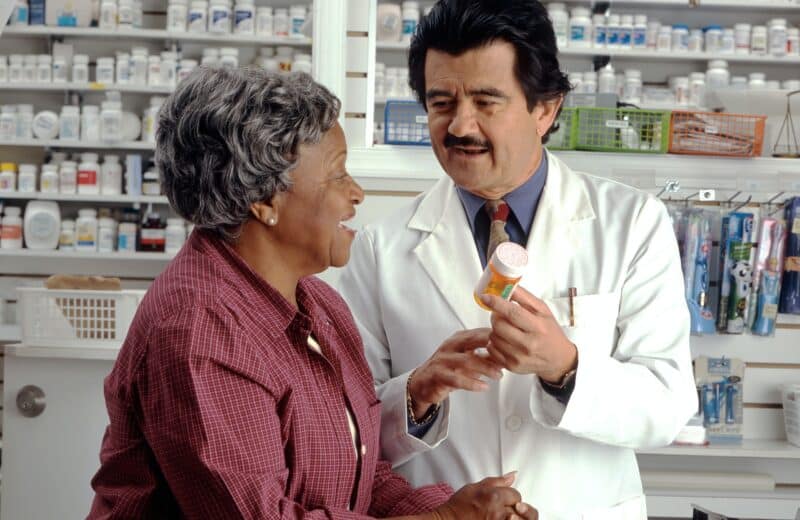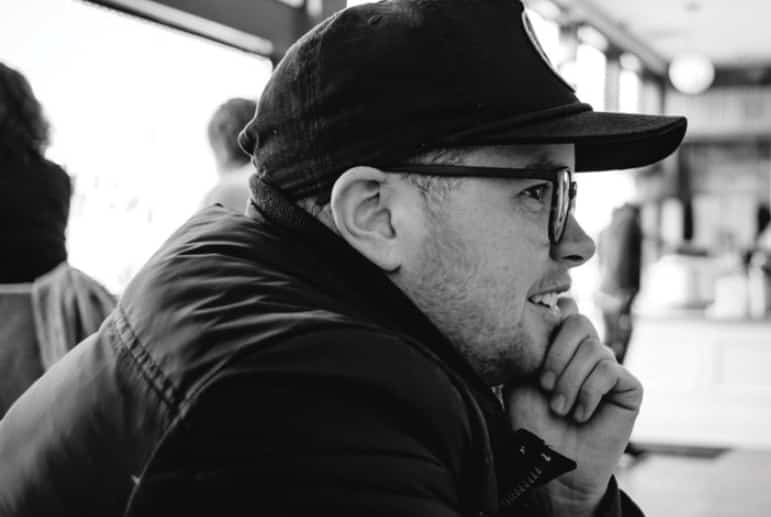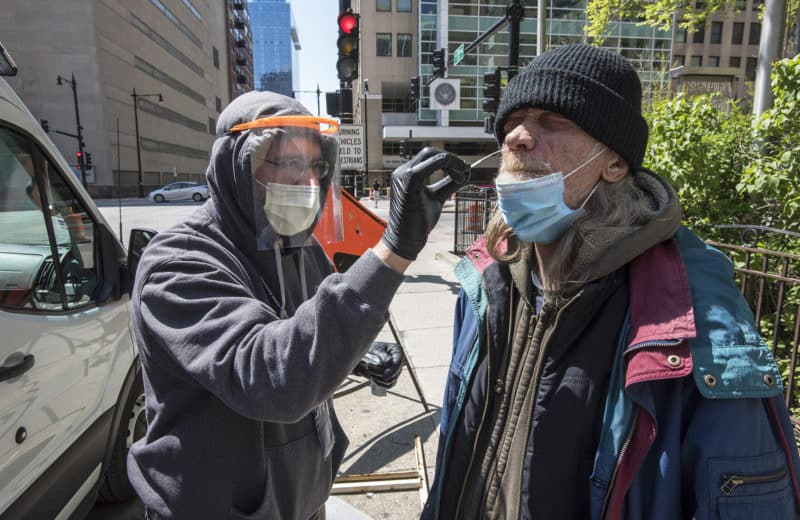From emotional support to cancer detection, dogs leave their medical mark
The office where orthopedic surgeon Leon Benson, MD, sees patients resembles any welcoming physician’s office: soft carpeting, bright walls, friendly staff. Nothing appears out of the ordinary — at first.
Then, the handle of Benson’s office door turns, the door swings open and a black, curly-haired Portuguese Water Dog sprints from the room. A gray dog of the same breed follows, heading straight for the patient exam rooms.
“That’s the biggest problem lately. Cooper has figured out how to use the handle to open exam room doors,” Benson says.
Cooper, 7, and Chelsea, 12, are Benson’s dogs — family additions initially spurred by his daughter’s request for a guinea pig. Benson, a hand surgeon with the Illinois Bone & Joint Institute in Glenview and vice chairman of the Department of Orthopedics at NorthShore University HealthSystem, had Cooper and Chelsea certified through Therapy Dogs International and has brought them into his office for the past seven years.
“I see a lot of people who have been hurt, and dogs know [when someone feels anxious]. Cooper will sit up on the bench next to a kid and sniff and nuzzle them,” Benson says.
Cooper and Chelsea serve as distraction and comfort. This isn’t unique to Benson’s practice: Dogs are increasingly common in medical settings, from dentists’ offices to hospitals.
Modern Healthcare reported in 2015 that nearly 90 percent of hospitals in the U.S. allow therapy animal visits. However, the role of dogs in medicine goes beyond therapy. Service dogs also work in medical settings, including:
• Guide dogs — aiding people with visual impairments.
• Psychiatric service dogs — detecting psychiatric episodes before onset.
• Seizure alert dogs — guarding a person during a seizure or going for help.
• Sensory signal dogs — interrupting repetitive movements, such as hand flapping, in people with autism.
Researchers are even training dogs to detect cancer. But unlike other therapy and service dogs, the medical community has been slow to accept this type of training.
Sniffing out cancer
In Canada, researcher and dog trainer Glenn Ferguson of CancerDogs, a cancer screening service, fights the status quo with a half dozen mixed breed hound dogs — and the Chicago Fire Department.
Because firefighters are at a higher risk of developing cancer, CancerDogs sought them out. Chicago’s fire department was one of the first groups to volunteer, followed by firefighters in California, Oklahoma and Texas. The research sample from Chicago alone grew from 500 firefighters to 3,200 in three years.
Ferguson says his research process is fairly simple. Participants breathe into a mask for 10 minutes and mail it back in a foil pouch for the dogs to sniff. When the dogs detect cancer — as they did in seven of the initial 500 samples from Chicago — they’re recognizing a cocktail of odors. Ferguson hasn’t identified exactly what the odors are, but he says cancer’s hallmark scent likely comes from hormones and byproducts of rapid cell growth. In fact, the first false positive the dogs identified was pregnancy — a prime example of rapid cell reproduction.
When the dogs identify a suspicious sample, CancerDogs encourages the participant to follow up with a physician. “This is not a diagnosis of cancer. This is a suspicion of cancer,” Ferguson says. “Dogs don’t indicate a tissue of origin. They’re identifying a group of people that should get further testing, because they’re detecting cancers before people’s doctors can diagnose it.”
However, acceptance has been slow. “The medical establishment has not been pursuing [cancer-sniffing dogs] because they don’t fit into the patented medical technology that companies are looking for,” Ferguson laments.
Providing purpose
Detecting cancer isn’t the only way dogs are saving lives. On Monday evenings, five dogs gather at the Haymarket Center, an addiction recovery facility in Chicago’s West Loop. A dozen people soon follow, sitting in pairs or in small groups with the dogs.
Today, explains Callie Cozzolino, executive director of Canine Therapy Corps, everyone will teach their dog a new trick. At the end of the hour, they’ll regroup to showcase the new tricks.
This is one of the psychosocial groups that Canine Therapy Corps works with. They run a similar program at the Jesse Brown VA Medical Center for veterans dealing with post-traumatic stress disorder.
“They could be working through a variety of different things, like low self-esteem and confidence. The ability to handle a dog and get a certificate at the end can be a big boost,” says Ann Davidson, operations manager for Canine Therapy Corps.
Each week, participants work with the same dog, developing a bond through obedience and agility training — always keeping the end goal in mind.
“It helps [participants] become more outcome-focused. You’re going to be more successful if you break it into smaller pieces,” Davidson says.
During the hour at Haymarket, volunteer Jaime Archer and her Blue Heeler mix, Jack, work with two women. They’re trying to teach Jack to stay and come when called.
“Good boy, Jack!” they cheer when he follows their commands.
Jack is patient but also carries a nervous energy, a feeling some of the program’s participants know well. Archer says she found Jack on the side of a road, a bullet lodged in his face.
Another dog, Swindle, had spent six months locked in a cage at Animal Care and Control, with little human interaction. Cozzolino adopted the Pit Bull and helped him to a better place mentally and physically. Swindle’s story hit home with the participants at the Jesse Brown VA program. “You mean Swindle has doggy PTSD?” one veteran asked.
Cozzolino ends the Monday night Haymarket session by asking everyone what challenges they faced with their dog that day. She spends a few minutes discussing how those same frustrations relate to the rest of their lives and what they can do about it.
Back in the north suburbs, Benson leans against his office door, reflecting on how his dogs bring purpose to his patients’ lives and his life, too. He’s currently recruiting 40 children into a study to see how hanging out with Chelsea and Cooper impacts their anxiety before, during and after they get a cast cut off.
Benson doesn’t think the findings will reveal anything groundbreaking. He just knows what he sees in his office. “What you find is the patients who don’t want to come back unless the dog is there. I’ve had patients who have come in just to see my dogs and then leave. They’re good to go. They don’t even need to see me.”












